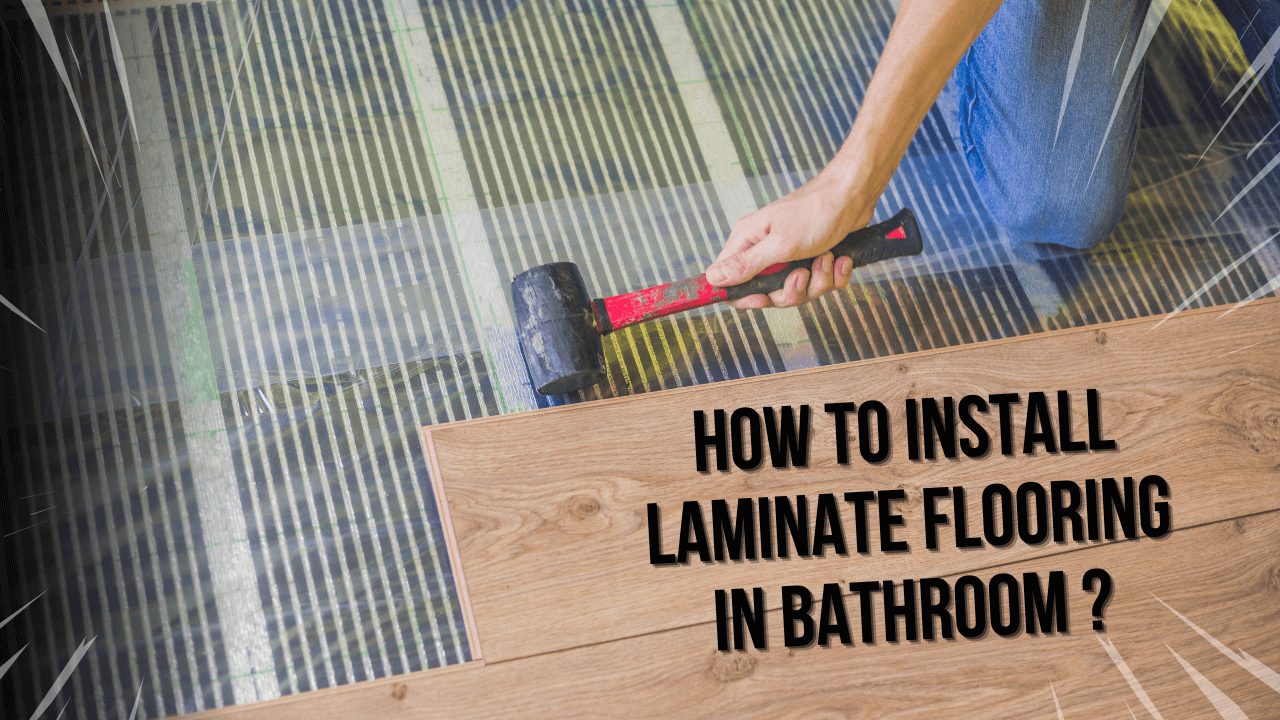Understanding the Challenges of Laminate Flooring in Bathrooms: How To Fit Laminate Flooring In Bathroom

Bathrooms are known for their high humidity and potential for water spills, making them challenging environments for traditional flooring materials. While laminate flooring offers durability and affordability, its susceptibility to moisture poses significant concerns in a bathroom setting.
Choosing Waterproof Laminate Flooring
The key to successfully using laminate flooring in a bathroom is selecting a waterproof option specifically designed for high-moisture areas. These floors are engineered with a core that resists water penetration, making them suitable for environments where spills and splashes are common. Standard laminate flooring, on the other hand, is not waterproof and can be damaged by prolonged exposure to moisture.
Comparing Laminate Flooring with Other Bathroom Flooring Options, How to fit laminate flooring in bathroom
Laminate flooring offers several advantages compared to other bathroom flooring options, including tile and vinyl.
Laminate Flooring Pros and Cons
- Pros:
- Cost-effective: Laminate flooring is generally more affordable than tile or natural stone.
- Variety of styles: Laminate flooring offers a wide range of styles and designs to complement any bathroom decor.
- Easy installation: Installing laminate flooring is relatively straightforward, making it a DIY-friendly option.
- Durability: Laminate flooring is known for its resistance to scratches and dents.
- Cons:
- Moisture sensitivity: Traditional laminate flooring is not waterproof and can be damaged by water exposure.
- Limited water resistance: Even waterproof laminate flooring has limitations and may not withstand prolonged exposure to standing water.
- Cold feel: Laminate flooring can feel cold underfoot, especially in colder climates.
Tile Pros and Cons
- Pros:
- Water-resistant: Tile is highly resistant to water and moisture, making it ideal for bathrooms.
- Durable: Tile is known for its durability and longevity.
- Variety of styles: Tile offers a wide range of styles, colors, and textures to suit any bathroom design.
- Cons:
- Expensive: Tile flooring is generally more expensive than laminate flooring.
- Difficult installation: Installing tile flooring requires specialized skills and tools.
- Cold feel: Tile flooring can feel cold underfoot.
Vinyl Pros and Cons
- Pros:
- Waterproof: Vinyl flooring is completely waterproof and resistant to moisture.
- Affordable: Vinyl flooring is generally more affordable than tile but more expensive than laminate.
- Easy installation: Installing vinyl flooring is relatively straightforward.
- Comfortable: Vinyl flooring is softer and more comfortable underfoot than tile or laminate.
- Cons:
- Limited durability: Vinyl flooring is not as durable as tile or laminate.
- Less stylish: Vinyl flooring often has a less sophisticated appearance than tile or laminate.
Tips and Considerations for a Successful Installation

Installing laminate flooring in a bathroom requires careful planning and execution to ensure a long-lasting and beautiful finish. Understanding the specific challenges of this environment and implementing the right techniques will make a significant difference in the final result.
Acclimation and Expansion Gaps
Proper acclimation is crucial for laminate flooring in humid environments like bathrooms. Laminate flooring is susceptible to expansion and contraction due to changes in humidity and temperature. Acclimation allows the flooring to adjust to the bathroom’s environment before installation. This helps prevent warping, buckling, and other issues that can arise from improper acclimation.
- Allow the laminate flooring to acclimate in the bathroom for at least 48 hours before installation. This gives the flooring time to adjust to the temperature and humidity levels.
- Store the flooring in its original packaging in a dry, well-ventilated area.
- Avoid installing laminate flooring in areas where it will be exposed to direct sunlight or excessive heat.
Expansion gaps are also essential for laminate flooring in bathrooms. These gaps allow the flooring to expand and contract without putting stress on the boards.
- Leave a minimum of 1/4-inch expansion gap around the perimeter of the room, as well as between the walls and any fixed objects like cabinets or tubs.
- Use expansion gap spacers to maintain the proper distance between the boards and the walls.
- These spacers can be removed after the flooring is installed.
Cutting and Transitions
Cutting laminate flooring around obstacles and creating transitions between different flooring types is a common challenge in bathroom installations.
- Use a circular saw or jigsaw to cut the flooring around obstacles.
- For transitions between different flooring types, consider using a transition strip. These strips are designed to bridge the gap between two different flooring materials and provide a smooth transition.
- To create a seamless transition between laminate flooring and tile, use a tile-to-laminate transition strip.
- For a transition between laminate flooring and carpet, use a carpet-to-laminate transition strip.
- These transition strips are available in various styles and materials to match your bathroom’s design.
Other Important Considerations
- Use a moisture-resistant underlayment. This will help protect the laminate flooring from moisture damage and create a more comfortable surface to walk on.
- Seal the seams between the laminate flooring boards with a waterproof sealant. This will help prevent water from seeping into the subfloor and causing damage.
- Avoid using excessive amounts of adhesive when installing laminate flooring in a bathroom. Too much adhesive can trap moisture and lead to warping or buckling.